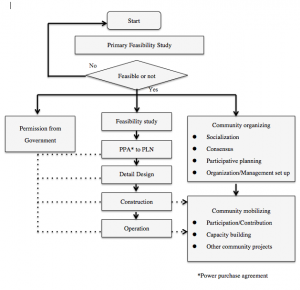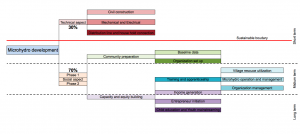IBEKA’s experience about community development
[Introduction]
IBEKA, an Indonesian abbreviation of Inisiatif Bisnis dan Ekonomi Kerakyatan or People Centered Business and Economic Initiative in english,This initiative is established in late 1992 by Iskandar Budisaroso Kuntoadji, one of the Mandiri Foundation founder that is original NGO group developed by 22 student of Bandung Institute of Technology.(1)
IBEKA aims at community development or moreover empowerment the marginal people by using their knowledge about appropriate technology, sociology and renewable energy especially micro head power.
(1)IBEKA website http://ibeka.netsains.net
[Background]
Population of Indonesia is 252,812,245(2). It is the 4th largest number in the world (3). Furthermore, Indonesia comprises over 17,000 islands (4) and diverse range of ethnic groups. (table. 1) Population share between urban area and rural area is almost 50:50.
Electrification ratio in Indonesia is reported as 73% in 2011,(6) although it might be overestimated according to IBEKA’s experience about electrification in rural area. In fact in villages in Java island, electrification rate is 57.56% and outside Java, it is much worse, only 48.27%. (7)
To cope with low electrification ratio in Indonesia especially in marginal area, mini/micro hydro power have quite high potential to be developed. Indonesia has a lot of water energy resource. The resources have been estimated to be able to provide electricity of 74,976 MW capacity with annual energy output equal to 401 billion kWh. However it is only 5% that has been exploited for electricity, 62% in Java and 38% outside Java. (8)
Table.1 Ethnic group in Indonesia (5)
(2),(3),(4),(5) World population review.com http://worldpopulationreview.com/countries/indonesia-population/
(6) IEA.
(7),(8)Development of mini/micro hydro power plant for rural electricity in Indonesia, Sarawono Hardjomuljadi and Sriyono D.Siswoyo
[Type of hydro power plant project]
Hydropower are classified into 3 classes according to its power-scale. In Indonesia hydropower plant smaller than 250kW referred as micro hydro and those smaller than 5MW referred as mini hydro. (9) Availability of hydropower plant in villages is determined according to the size of hydro power plant. Small power-scale (<250kW) is available in many village, medium power-scale(<5MW) is less available and large power-scale is rarely available. IBEKA identifies installation model of hydropower plant based on this classification. The small power-scale hydropower plant project should be non-commercial and community base project, the medium power-scale hydropower plant project should be semi commercial and social business base project and the large power-scale hydropower should be commercial business base project. The Small and medium power-scale hydropower project would benefit for poor/poverty community and the large power-scale hydropower project would get benefit for capital owner. There are two categories of electricity distribution: 1. Distributed directry through PLN distribution line (called “on grid”) and 2. Distributed separately from PLN distribution line (called “ off grid”).(10) Micro hydropower plant on grid mostly is operated by PLN, and Micro hydropower plant off grid is mostly developed by private sector of middle small industry and village cooperative. In the small and middle power-scale hydropower project, off grid are mostly chosen and the large power-scale hydropower on grid are mostly chosen. (9) ,(10)Development of mini/micro hydro power plant for rural electricity in Indonesia, Sarawono Hardjomuljadi and Sriyono D.Siswoyo [IBEKA’s initiative for community development or social business]
Community development is one of the most important purposes of IBEKA’s activities. There are three important factors in IBEKA’s initiative for community development. The first factor is local community respect. The second is participatory development and the third is community empowerment. Local community respect develops pro-local wisdom, participatory development brings local equity, and community empowerment grows local capacity. And these three factors support each other and bring synergy effect.
Community development divided two aspects. One is personal empowerment and the other is structural empowerment. Motivation, self-confidence, self-valuation, positive experience, self-reliance and creativity is key factors for personal empowerment. These factors are grown up in local resource and become a root of realistic formulation, organizational capacity/capability, subsequent cost for sustainability, orientation, technical appropriateness, consideration of political structures. These are basic factors of structural empowerment. In addition to that, good governance such as political stability, favorable economical and social trends or ecological soundness or food environmental condition supports community development. Empowered structures contribute advice, training, technology, and finance to local resource.
[IBEKA’s community development project procedure]
In IBEKA’s project implement scheme, project implement procedure is divided into 5 phases; rough-survey phase, recognizance phase consolidation phase, self organizing phase and sepf reliant phase.
In rough survey phase, basic existing data mainly renewable energy potential such as characteristics are gathered. Then IBEKA staffs visit a village and talk to informal leader, formal leader and some sample villagers to see more detail information. Important thing in this phase is “Anything can be promised before confirmation”. Staffs talk to the villagers about only basic information but detail and do not promise anything in this phase.
When possibility is confirmed through the rough survey, IBEKA start to find developers. Then the project moves to the next recognizance phase. This phase takes about 3 month. IBEKA staffs stay in the village and develop community baseline data collection and community social structure mapping based on social and managerial aspect and resource data assessment based on technical aspect. The goal of this phase is to improve the floating mass awareness among villagers. The next 9 month is consolidation phase. Staff and villagers construct the facilities, initiate organization to handle the facility. IBEKA staffs guide how to construct, how to maintain, how to allocate the benefit from the facility and build a consensus among villagers. Villagers decide the leader of organization or how to allocate the benefit by them self by voting. After this phase self-organizing phase and self-reliant phase are following and through those phases, the organization are ready to be reinforced. Among these phases the recognizance phase is the most critical phase. If floating mass awareness is improved enough, project proceeds successfully. Development task flow shows in Fig.1
[Task mapping]
Task mapping is also crucial idea to run sustainable community development. For example as I show in Fig 2. Micro hydro development project is divided into two aspects; technical aspect, in terms of civil construction, Mechanical and electrical, and distribution line and household connection, and social aspect. IBEKA clarify importance weight as 30% on technical aspect and 70% on social aspect.
Social aspect is further divided into two aspects, community preparation and capacity and equity building. Community preparation includes development of baseline data and setting up local organization. Capacity and equity building includes, first training and apprenticeship, in terms of village resource utilization, micro hydro operation and management and organization management, second income generation, third entrepreneur initiation and forth child education and youth mainstreaming.
As mentioned earier, social aspect is much more important than technical aspect, without social aspect, community development project is never achieved. This is called as “sustainable boundary”. Furthermore community preparation bring short-term success, training and apprenticeship and income generation make sure medium term success, and entrepreneur initiation and education for next generation achieve long-term success.
Fig.1 Development process task flow
Fig.2 Task mapping of Micro hydro development

